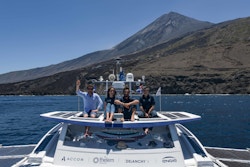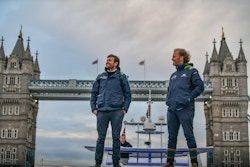Energy Observer, an ambassador of alternative solutions
The vessel is at the halfway point of the first transatlantic crossing using renewable energies and hydrogen. An “anniversary” that comes in a difficult global context but which shows that concrete initiatives are already underway to rethink our world in a more harmonious way. Interview with Victorien Erussard and Jérôme Delafosse.

3 years already since the launch of Energy Observer! What are the elements that have marked these first pages of the vessel’s history?
Victorien Erussard (V.E.): “First of all the technological challenges, because what seemed impossible a few years ago has become a reality: from the first on-board green hydrogen production system in 2017, self-sufficient and without carbon emissions on nature, to the first navigation on Svalbard without fossil fuels in 2019.
Our responsibility is both to test and validate technologies to make them accessible to as many people as possible, and to enable people to project themselves into a more responsible future with concrete solutions. But also to reach out to those who are committed and develop intelligent, resilient initiatives through our audiovisual content.”
Jérôme Delafosse (J.D.): “This human adventure has enabled us to lead a positive Odyssey at sea and on land, meeting women and men who are reinventing energy, agriculture, the economy, solidarity, and those who are finding solutions to protect biodiversity.
Our vessel is a floating laboratory, but it is also a symbol that prefigures the world of tomorrow: consuming only the energy we produce, producing green energy on a massive scale at an affordable cost, valuing the people who make, who put their know-how at the service of concrete solutions for the energy, social and environmental transition."
“This first phase of the three-year odyssey in Europe has really enabled us to test and validate our embarked technologies, so that we can now deploy them on a large scale both at sea and on land.”

Happy Birthday Energy Observer !
It’s quite a special anniversary, as the boat is in the process of completing her first transatlantic crossing without you on board. What do you wish the crew ?
V.E. : "C’est la plus grande distance que le bateau va parcourir en totale autonomie à ce jour ! Et de plus, uniquement propulsé aux énergies renouvelables et à l’hydrogène. Un signal fort, un challenge incroyable pour le bateau comme pour l’équipage (notamment les marins que nous sommes).
Evidemment j’aurais beaucoup aimé être à bord pour cette première transocéanique, mais nous avons préféré préserver la santé de l’équipage et respecter les règles de confinement.
L’équipage suit les directives gouvernementales et sanitaires et n’a pas mis le pied à terre depuis plus de 20 jours. C’est un challenge pour eux, car ils ne devaient pas partir aussi longtemps, ils sont éloignés de leurs familles et ont dû trouver des moyens d’être autonomes pour produire leur propre eau potable et optimiser l’avitaillement car certains pays refusaient même que le bateau reste au mouillage.
Nous sommes en contact quotidien avec eux, et savons que même si c’est dur, ils sont en train de mettre en œuvre des solutions concrètes à bord du navire. C’est une aventure unique !“

J.D.: “They didn’t know it was impossible so they did it: that’s been Energy Observer’s motto since the beginning of the Odyssey!
Of course I’d like to be on board with the crew, to live these historic moments with them. But resilience also means knowing how to adapt to difficult situations, and this crisis reminds us of order, enjoins us to be humble and to put our individual needs ahead of bigger causes.
Energy Observer is not only the story of two founders, it is a human adventure with sailors, engineers, explorers, and above all passionate people! It is this diversity of talents and personalities, this human mix, which is also our strength and which allows us to adapt to all situations, just like the technological mix on board the boat.”
The current health crisis questions us – among other things – both about our lifestyles and our relationship with nature. How can the Sustainable Development Goals help us to imagine and build the world afterwards?
V.E.: "The fact that this health crisis has very quickly become a global economic and social crisis shows that everything is linked, just like the interdependence of the pillars of sustainable development: to a complex problem, there can be no answer that would only concern ecology, the economy or social equality.
Not only do we need to change our production model, but also our lifestyles, our relationship to the environment, development, health, etc., as well as the way we live. The 17 SDGs now find a concrete and dramatic translation in the Covid-19 crisis, and they are our best asset to get out of this situation in a better way.
This unprecedented crisis must lead us to be more responsible on an individual and collective scale, to challenge our current models and to lay the foundations of the “next world” for the well-being of people and our children, while respecting our planet.”
“This crisis is as much ecological as it is health-related, and warns us while at the same time offering us a unique opportunity to move forward and build a fairer world.”
J.D.: “We have been thinking about this world for a long time with Energy Observer! As the first ambassador of the Sustainable Development Goals, we believe that these 17 objectives all demonstrate their relevance in understanding the crisis and working towards a more sustainable future.
At our level, we wish to pursue our mission and of course to share all the solutions we have been able to identify to act intelligently on all aspects of the transitions: climate through the deployment of clean energies and green hydrogen, but also globally ecological and social.”
To go further:
